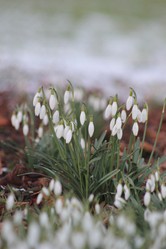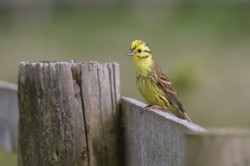This was a morning walk to culminate in lunch, so we arrived at our destination, an inn dating from the eighteenth century, a lovely edifice of stone called Leather's Smithy. It was still shut and we could not use the car park, so we parked on the lane near the reservoir and set off along a footpath running along the road.The hill to our left was rich in towering pine trees, but nearer to us were stands of birch coppice, their proliferation of stems and large stools revealing that they had had seen many a cycle of coppicing and regrowth. [For information on coppicing see my Wizzley article.] My grandson loved the footpath, as he could run free safe from cars.
We crossed the lane and strolled down the footpath alongside the lake. Already I was feeling confident, as I knew that my pace was keeping up. We walked through a quiet woodland shaded by pine trees, but not so densely planted that it had bare soil, like many conifer plantations. Moss and fern covered much of the ground that ascended to our left.We resisted the temptation to explore paths that took us deeper into the wood, not that getting lost is a serious possibility. To our right the sun glinted on the deep, tranquil water. We could safely let our grandson run, as the reservoir was protected by a fence.
The path had some ups and downs, some steep, but they did not cause me any bother, another sign of progress, as my condition resulted in a diminished balance.
We came to newer plantings. There were some holly trees, beech saplings that still retained shrivelled, brown leaves, and young oak whose newly planted stems were girdled with spiral rabbit guards, defence against not only rabbits but also muntjac, dog-sized Chinese barking deer, escapees from captivity that have become established in Britain. They can ring bark young trees, stripping away protective bark and thus destroying the trees' ability to send the products of photosynthesis down to the roots.Ring barking is always fatal to a tree.
We arrived at the damn at the end of the reservoir. Peter took hold of my grandson for safety reasons, as the damn sloped steeply away to our left. Even though the fencing was strong and secure you cannot be too careful with young children. By the time that we had crossed the damn we were coming out of the wood and walking down a country lane past verdant fields on the way to the inn.
I had not only kept up the pace, but I had not had to take a break, and I had had no pain at all in the affected areas. Signs of recovery! A walk short but successful.








 Pilgrimage. A reviewon 06/15/2025
Pilgrimage. A reviewon 06/15/2025
 Leo the Fourteenthon 05/09/2025
Leo the Fourteenthon 05/09/2025
 The Melsonby Hoardon 03/25/2025
The Melsonby Hoardon 03/25/2025




Comments
It varies with the taste ofbthe individual
Thank you for your comment below in answer to my previous comment and question.
Bottled, selzer and sparkling waters include among their appeals their coldness.
Do British Isles-ers drink such non-tap alternatives at room temperature or with refrigerated temperatures?
America probably has a wider range of flavours than Britain does, but we have a range of types of sparkling water.
Thank you to Frank and Veronica for their comments below in answer to my previous observation and question.
The sparkling water with which I best am acquainted is the Kroger grocery store brand. That brand offers store customers flavors, such as my favorite blood orange and pineapple coconut flavors.
Would sparkling water just be a generic sparkling water in British-Isles inns and pubs or would it welcome its purchasers to a flavor array such as the above-mentioned Kroger brand?
Thanks Veronica.
They could some do.
Sparkling water is avilable to buy at inns and pubs . Tap (faucet ) water has to be available at no charge in English pubs and inns.
Thank you for your comment below in answer to my previous observation and question.
Grocery stores carry not only bottled water but also selzer and sparkling water. Might inns offer the two latter as pay options in addition to "plain" bottled water?
https://wizzley.com/tegg-s-nose/
Frank, Macclesfield forest is beautiful. We have been visiting Tegg's Nose ( Near Macc Forest ) for years.
The link is above .
Derdriu, daffodils are blooming well over here.
I don't know about the red dye used in cheeses, sorry.
Water generally comes free in inns, but you have to ask for it. It is tap water from the mains supply, but bottled water is usually charged for.